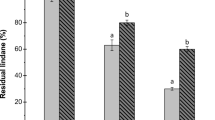Abstract
While mostly, bacterial bioremediation is used for degradation of recalcitrant organic contaminants, heavy metal resistant soil bacteria can minimize metal leaching, and in combination with short rotation coppice produce sustainable lignocellulose for re-use of degraded soils, e. g. in former mining areas influenced by acid mine drainage. To understand the molecular heavy metal resistance mechanisms of strains able to cope with the autochthonous microbiome is prerequisite to their use.
Similar content being viewed by others
Literatur
Kothe E, Büchel G (2014) UMBRELLA: Using MicroBes for the REgulation of heavy metaL mobiLity at ecosystem and landscape scAle. Environ Sci Pollut Res Int 21: 6761–6764
Schrempf H, Keller U (2016) Streptomyceten: Relevanz für Ökologie, Medizin und Biotechnologie. BIOspektrum 1: 22–25
Bogdanova O, Kothe E, Krause K (2023) Ectomycorrhizal community shifts at a former uranium mining site. J Fungi 9: 483
Schütze E, Klose M, Merten D et al. (2014) Growth of streptomycetes in soil and their impact on bioremediation. J Hazard Mater 267: 128–135
Brangsch H, Höller M, Krauße T et al. (2022) Extremophile metal resistance: Plasmid-encoded functions in Streptomyces mirabilis. Appl Environ Microbiol 88:e0008522
Dimkpa CO, Merten D, Svatos A et al. (2009) Siderophores mediate reduced and increased uptake of cadmium by Streptomyces tendae F4 and sunflower (Helianthus annuus), respectively. J Appl Microbiol 107: 1687–1696
Harpke M, Kothe E (2023) Biofilm formation in Grampositives as an answer to combined salt and metal stress. J Basic Microbiol 63: 888–896
Hermann L, Mais CN, Czech L et al. (2020) The ups and downs of ectoine: structural enzymology of a major microbial stress protectant and versatile nutrient. Biol Chem 401: 1443–1468
Kung C, Martinac B, Sukharev S (2010) Mechanosensitive channels in microbes. Annu Rev Microbiol 64: 313–329
Phieler R, Voit A, Kothe E (2014) Microbially supported phytoremediation of heavy metal contaminated soils: strategies and applications. Adv Biochem Eng Biotechnol 141: 211–235
Author information
Authors and Affiliations
Corresponding author
Additional information
Danksagung
Für die rasterelektronenmikroskopischen Aufnahmen danken wir Andre Schmidt und Eileen Schütze sowie Sandor Nietzsche.
Erika Kothe
Jahrgang 1960. Biologiestuidum in Marburg. 1988 Promotion. 1989–1991 PostDoc an der University of Vermont, Burlington VT, USA und der Rijksuniversiteit Groningen, Niederlande. 1991 Wissenschaftliche Assistentin am Lehrstuhl Molekulargenetik in Marburg. 1997 Habiliation in Marburg. 1997–2012 Professur für Mikrobielle Phytopathologie und seit 2012 Professur für Mikrobielle Kommunikation an der Universität Jena.
Katrin Krause
Jahrgang 1971. Biologiestudium in Jena. 2005 Promotion in Jena. Seit 2005 Wissenschaftliche Angestellte am Lehrstuhl für Mikrobielle Phytopathologie und seit 2015 Arbeitsgruppenleiterin am Lehrstuhl für Mikrobielle Kommunikation in Jena.
Marlene Höller
Jahrgang 1994. 2015–2019 Studium BSc/MSc Biogeowissenschaften in Jena. Seit 2019 Promovierende am Lehrstuhl für Mikrobielle Kommunikation in Jena.
Rights and permissions
About this article
Cite this article
Kothe, E., Höller, M. & Krause, K. Kleine Helfer: Streptomyceten für die Bioremediation. Biospektrum 30, 386–389 (2024). https://doi.org/10.1007/s12268-024-2212-z
Published:
Issue Date:
DOI: https://doi.org/10.1007/s12268-024-2212-z




